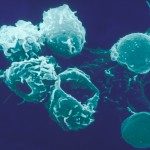Link to Pubmed [PMID] – 9808206
Eur. J. Immunol. 1998 Oct;28(10):3362-70
Genes encoding the heavy chain portion of immunoglobulin molecules arise from the combinatorial association of V, D and J gene segments, which occurs during discrete stages of B lineage development in the bone marrow. Recently, V(H) replacement, a form of receptor editing, has been described, in which the variable region of an existing VDJ(H) rearrangement is replaced by another V(H) gene segment in a recombination event believed to involve an embedded heptamer within the coding region of the V(H). Studies of transgenic mice with “knocked-in” VDJ(H) genes encoding anti-DNA specificity have demonstrated that receptor editing of the heavy chain is one mechanism by which autoreactive B cell receptors can be modified. Another mouse, the “quasi-monoclonal”, which encodes a “knocked-in” VDJ(H) for the hapten NP also contains B lineage cells that undergo V(H) replacement. This suggests that V(H) replacement may play a role in the normal diversification of the antibody repertoire. Using a ligation-mediated PCR assay, we have identified V(QM) double-stranded DNA breaks indicative of V(H) replacement intermediates from bone marrow and splenic B lineage cells of quasi-monoclonal mice in the absence of immunization. V(QM) to J558 recombination deletion products consistent with V(H) replacement were also detected in both the bone marrow and spleen of non-immunized quasi-monoclonal mice. Moreover, RAG-1 transcripts were detected in the spleen. These data suggest that V(H) replacement can be part of the mechanism(s) used by B lineage cells to generate diversity throughout B lineage development, including later stages occurring in secondary lymphoid tissues.

